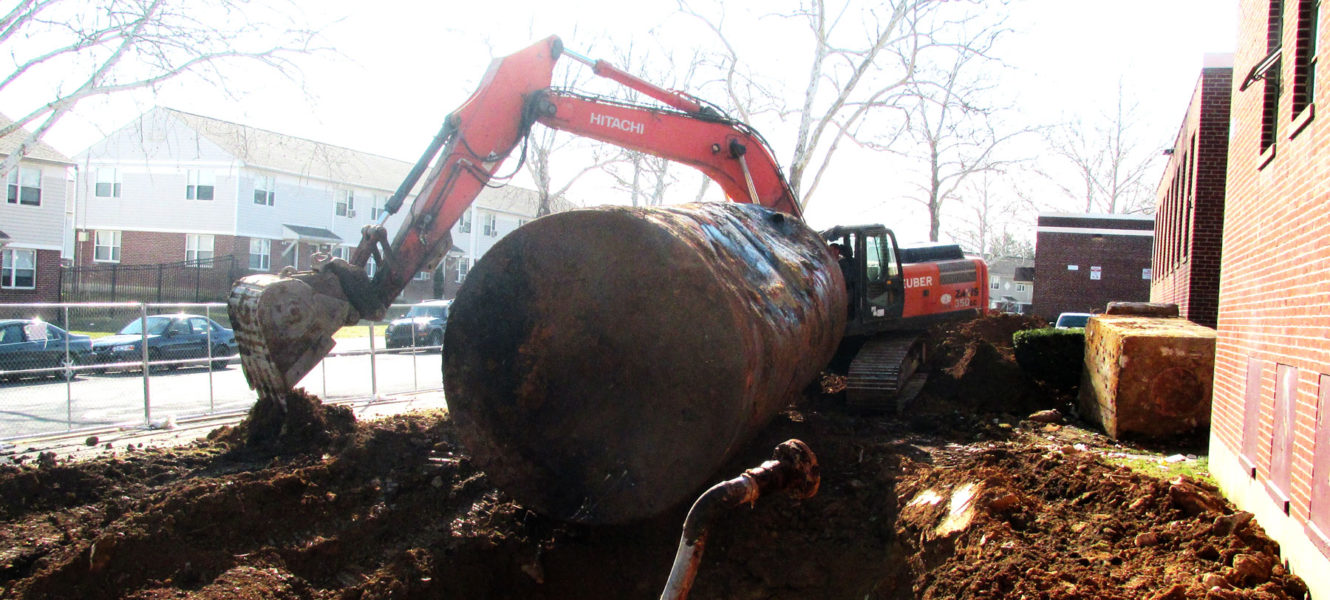 Overseeing removal of the first 15,000-gallon underground storage tank.
Overseeing removal of the first 15,000-gallon underground storage tank.Release of No. 6 Fuel Oil in Reading
A release of No. 6 fuel oil in Reading, Pennsylvania gets nowhere fast. No. 6 fuel oil is a dense, viscous oil that looks more like tar than it does heating oil. It migrates from the soil to groundwater very slowly, if at all. Residual oils from fuel oils and lighter hydrocarbons that are distilled away in refinery operations are used to create No. 6 fuel oil. It was a relatively inexpensive heating oil for older boiler systems and for powering large ships but is not as common as it once was because of the rise in natural gas use and the air pollution associated with burning No.6 fuel oil. According to the Environmental Defense Fund, Burning No. 6 fuel oil creates 26 times more particulate matter (PM), four times more nitrogen oxides (NOx) and 527 times more sulfur dioxide (SO2) than burning natural gas (EDF Facts). New York City’s Clean Heat Campaign started the process of phasing out No. 6 fuel oil in 2012. The City indicated that the small percentage of buildings (1%) that burn residual fuels (No. 4 and No. 6) create more soot pollution than all the trucks and cars in the City combined. A natural gas heating system requires less maintenance than a boiler system fueled by No. 6 fuel oil which requires routine maintenance and scheduled deliveries of the oil. No. 6 fuel must be stored in heated storage tanks because of its tarlike characteristics make it solid at room temperature. Several businesses, government agencies, and school districts have switched over to natural gas to save on cost and time.
No. 6 Fuel Oil Leaking Underground Storage Tanks in Reading, PA
The Reading Housing Authority (RHA) recognized the negative impacts of No. 6 fuel oil and took their boiler system powered by No. 6 fuel oil used to heat the Oakbrook Homes development out of service in 2003. At that time RHA converted their residential heating systems over to natural gas because it was more efficient and cost effective, but due to budget constraints at the time. RHA was unable to decommission the boiler system completely. In 2015, RHA decided to remove the Oakbrook boiler house system to prepare the space for future renovations and use by the RHA maintenance department.
Element Environmental Solutions (E2S) was contracted by the RHA to conduct a hazardous material survey and prepare specifications for the removal of two underground storage tanks (USTs) in support of future renovations. E2S conducted the hazardous material survey which included a demolition style asbestos survey. E2S reviewed existing drawings, conducted a site survey and collected bulk samples for analysis. E2S did not identify any asbestos containing materials (ACM) or hazardous building materials during the survey. The facility was given a clean bill of health from a hazardous building materials standpoint, allowing renovations to occur without taking extra precautions to protect contractors against exposure to indoor air pollutants.
E2S provided technical specifications and bid forms for the removal of two 15,000-gallon USTs that contained No. 6 heating oil before the conversion to natural gas. E2S provided oversight during the removal, identifying a release of No. 6 fuel oil that impacted soils beneath the USTs. The release was believed to have occurred decades ago before the tanks were cleaned and closed in place. E2S developed a remedial action strategy at the time of the release and assisted the RHA with filing a claim for remediation costs through the Underground Storage Tank Indemnification Fund (USTIF). USTIF is a State program designed to “reimburse eligible participants for reasonable and necessary expenses incurred from releases into the environment.” Although the tanks at the RHA Oakbrook Development were closed in place in 2003, they were still eligible for reimbursement under USTIF since the tanks were covered by the insurance when the system was in use. RHA merely needed to provide proof of coverage for the tanks when they were in operation.
Immediately following the removal of the tanks, over 400 tons of impacted soils were removed and disposed of properly offsite as nonhazardous waste. A soil boring investigation showed that the extent of the impact was limited to the edges of the excavated area. Approximately 92 cubic yards of soil was unable to be removed from the excavation due to building and sidewalk structural concerns; therefore, it was managed on site under Act 2’s Site Specific Standard. An engineered geosynthetic environmental cap was placed over the impacted soils to eliminate any exposure pathways and to demonstrate attainment of the Site Specific Standard. During the groundwater investigation, E2S determined that groundwater was not impacted and RHA sought a release of environmental liability under the Act 2 Statewide Health Standard. A vapor intrusion investigation was also completed, indicating there was no evidence of vapors from the impacted area volatilizing into the soil gases. RHA received a release of liability site under the Act 2 Program and E2S presented the findings of the tank removal activities and remedial investigation to help finalize the USTIF claim.
If you are concerned with a release of hazardous materials or petroleum products on your property, E2S can guide your site through the appropriate voluntary cleanup program and help you receive a release of environmental liability.






